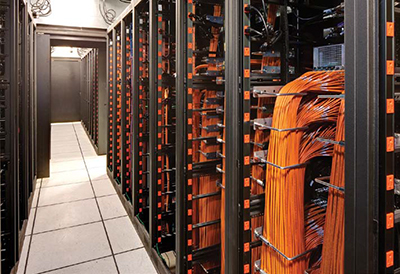Connecting for Faster Data Rates

The main equipment room at BYU Television houses 105 equipment racks serving four TV streams and four radio stations plus edit suites and general production areas.
SEATTLE—The integrity and quality of video production and transmission depends on the millions of feet of cable, fiber and connectors installed in broadcast and video facilities every year, something paramount in the minds of system integrators.
“You can’t afford to do it wrong,” said Jim Conley, senior vice president of engineering and chief technical officer for Communications Engineering, Inc. in Newington, Va. “You can’t afford to do it over.”
Mark Siegel, president of Advanced Broadcast Solutions in SeaTac, Wash., pointed out the quality and reliability of cable and connectors is really a dollars and cents issue for an SI.
“As a system integrator, one of the very few things that we warrant is the cabling and workmanship,” he said. “Therefore, cables and connectors are some of the most important things to me.”
Fred Beck, president and head of engineering for Austin-Texas,-based Beck Associates looked at the enormity of having to replace cable and/or connectors on just one project. “I have a truck here right now, and I think the truck has around 8,000 cables, which means we have around 16,000 connectors in this truck. If I put in a bad connector or a connector that proves to be bad, then I’m responsible for replacing all those connectors.”
AVOID GENERIC
Customers often have their own cable and connector preferences. “A lot of people, if they have an existing facility, want to stick with what has worked for them in the past,” said Joseph Policastro, principal and director of Project Management at Broadcast Integration Services in Union City, N.J. “So there’s a lot of brand loyalty to cables and connectors. The last thing the client wants to think about is having any sort of problems or gambling on any sort of an interconnect going wrong.”
The professional video industry's #1 source for news, trends and product and tech information. Sign up below.
Beyond the desire for name brands, system integrators want to buy tested and documented cables and connectors. For example, sweep tested cable has had all of the expected frequencies through it, with a resulting graph verifying that each cable meets the required specification. When the cable is pulled into place, cut to length and terminated with connectors by the installer, it’s tested again.
Justin Guzman, project engineer for Diversified Systems, Inc. in Columbus, Ohio, noted that the unit-cost savings for off-brand connectors can easily be eaten up in labor expenses. “They can be very time consuming, and requires a pretty skilled technician.”
Beck has a similar reason to standardize on a particular brand of cable: “We have found that with our automated stripping machines, and with our automated spooling machines, that even small variations in diameter make a big difference,” he said.
FUTURE-PROOF
The cable and connector industry isn’t one that can stand still. “We’re in a cycle of rapid turnover of formats and media,” said Policastro. “Things calmed down for a little while, but now we’re back up to a hundred different codecs and 50 different ways to store media.”
That has led to newer and higher capacity evolutions of cable. “Beyond Cat6 there’s Cat6a that is becoming the requested thing among some of our clients,” said DSI’s Guzman. “It’s 10 Gbps category cable as opposed to a 1 Gbps Cat6 category cable. Traditionally 10 Gbps always had to be a fiber cable, but with Cat6a you can actually do it over copper. And it’s not so much that any of our clients are actually doing 10 Gbps over copper yet, it’s more that they want to future-proof their infrastructure so when they’re ready to upgrade their hardware they don’t have to rerun all their cable.”

Mark Siegel of ABS
CEI’s Conley amplified that point. “Expected data rates for signal transmission are changing at such a rapid rate that we want to make sure that whatever we build today, it’s pretty much future-proof for at least this generation of technology, for the foreseeable future.”
In the IT world, there are 40 Gbps and even 100 Gbps systems available, according to Conley. “We keep our eye on fiber optics,” he said. “There’s OM3 and OM4, both handle 40 Gbps and 100 Gbps. We’re starting to specify fiber-optic cable that has those capabilities. So if we’re building 10 Gbps exchanges today, they’re going to be able to handle 40 and 100 Gbps exchanges when the devices change.”
Future-proof is, of course, a relative term, and it’s possible to know what the necessary specifications of cabling will be only so far down the road. ABS’ Siegel said that early in a facility’s architectural planning, the need to remove and replace cabling should be addressed. “As technology changes in the future, you’ve got to plan to pull your existing cabling—or a large part of it—out, to make room to pull the newer cable needed.”
Policastro pointed to a trend in video facility devices that’s affecting cables and connectors. “Just like everything else, they think more is better. So now they want to get 50 connectors on the backplane of a device that would normally only hold 10 or 15 previously,” he said. “And there’s an upstart coming back into the picture again is almost like a mini- BNC—micro BNC connectors.”
Beck cautions about smaller coax sizes with high-bandwidth cables, especially with long run lengths. “3G doesn’t like coax very much, and it especially doesn’t like mini-coax,” he said. “So we’re having to be very careful about run lengths in our trucks, and very careful about our run lengths and our types of cables in our fixed facilities. If our client even thinks that they should be prepared for 3G, we’re going to suggest to them that they put in larger diameter coaxes. It’s a simple fact of physics.”
